
USS Tortuga (LSD-26) was a Casa Grande-class dock landing ship in the United States Navy. She was the first Navy ship to be named for the Dry Tortugas, a group of desert coral islets 60 miles west of Key West, Florida, which were discovered in 1513 by Spanish explorer Ponce de Leon.

USS Monticello (LSD-35) was a Thomaston-class dock landing ship, the third ship of the United States Navy to be named for Monticello, Thomas Jefferson's home in Virginia.

USS Thomaston (LSD-28) was the lead ship of her class of dock landing ship of the United States Navy. She was named for Thomaston, Maine, the home of General Henry Knox, the first Secretary of War to serve under the United States Constitution.

USS Cabildo (LSD-16) was a Casa Grande-class dock landing ship of the United States Navy. She was named for The Cabildo in New Orleans, the old town hall and now a historical museum, where the formal transfer of the Louisiana Territory from France to the United States took place.

USS Rowan (DD-782) was a Gearing-class destroyer of the United States Navy, the fourth Navy ship named for Vice Admiral Stephen C. Rowan (1805–1890).
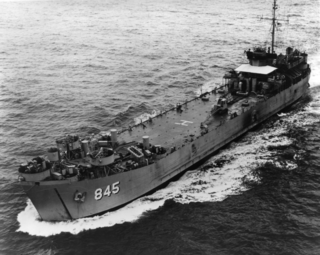
USS Jefferson County (LST-845) was an LST-542-class tank landing ship built for the United States Navy during World War II. Named after counties in 25 states, she was the only U.S. Naval vessel to bear the name.

USS Pickaway (APA/LPA-222) was a Haskell-class attack transport that saw service with the US Navy in World War II, the Korean War and the Vietnam War. She was of the VC2-S-AP5 Victory ship design type and named after Pickaway County, Ohio.
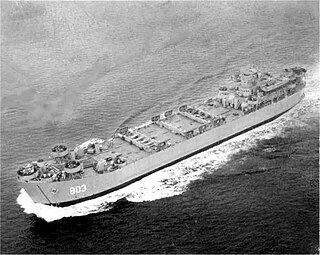
The USS Hampden County (LST-803) was an LST-542-class tank landing ship built for the United States Navy during World War II. Named after Hampden County, Massachusetts, she was the only U.S. Naval vessel to bear the name.

USS Delta (AK-29/AR-9) was the lead ship of her class of repair ships in the United States Navy during World War II. She was originally built as the merchant ship SS Hawaiian Packer before her requisition by the U.S. Navy in 1941. Before conversion to a repair ships, Delta briefly served as a U.S. Navy cargo ship.
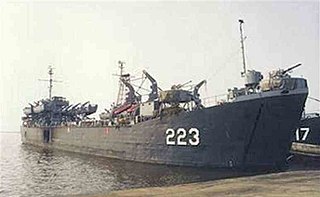
USS Iron County (LST-840) was an LST-542-class tank landing ship built for the United States Navy during World War II. Named after counties in Michigan, Missouri, Utah, and Wisconsin, she was the only U.S. Naval vessel to bear the name.

USS Lafayette County (LST-859) was an LST-542-class tank landing ship built for the United States Navy during World War II. Named after counties in Arkansas, Florida, Mississippi, Missouri, and Wisconsin, and a parish in Louisiana, she was the only U.S. Naval vessel to bear the name.
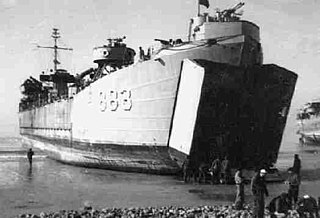
USS La Moure County (LST-883) was an LST-542-class tank landing ship built for the United States Navy during World War II. Named after LaMoure County, North Dakota, she was the first of two U.S. naval vessels to bear the name.
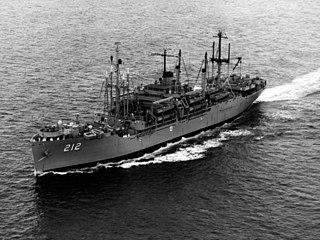
USS Montrose (APA/LPA-212) was a Haskell-class attack transport in service with the United States Navy from 1944 to 1946 and from 1950 to 1969. She was scrapped in 1970.
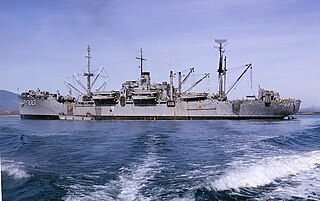
USS Renville (APA-227) was a Haskell-class attack transport that saw service with the US Navy in World War II, the Korean War and the Vietnam War.

USS White Marsh (LSD-8) was an Ashland-class dock landing ship of the United States Navy, named in honor of White Marsh, Virginia, the birthplace of Walter Reed (1851–1902).

USS Catamount (LSD-17) was a Casa Grande-class dock landing ship of the United States Navy, named in honor of the Catamount Tavern in Old Bennington, which served as headquarters for Ethan Allen's Green Mountain Boys while making their plans against the New Yorkers and the British. The Catamount was also the meeting place of Vermont's only form of government then: the Vermont Council of Safety.

USS Colonial (LSD-18) was a Casa Grande-class dock landing ship of the United States Navy, named in honor of the Colonial National Historical Park, which comprises Jamestown, Williamsburg, and Yorktown in southeastern Virginia.

USS Fort Marion (LSD-22) was a Casa Grande-class dock landing ship of the United States Navy. She was named for the Castillo de San Marcos in St. Augustine, Florida, which was named Fort Marion from 1821 till 1942.

USS Horace A. Bass (DE-691/APD-124/LPR-124) was a United States Navy high-speed transport in commission from 1944 to 1969.
ROCS Chung Cheng may refer to one of the following ships of the Republic of China Navy, all three named after President Chiang Kai-shek :




















